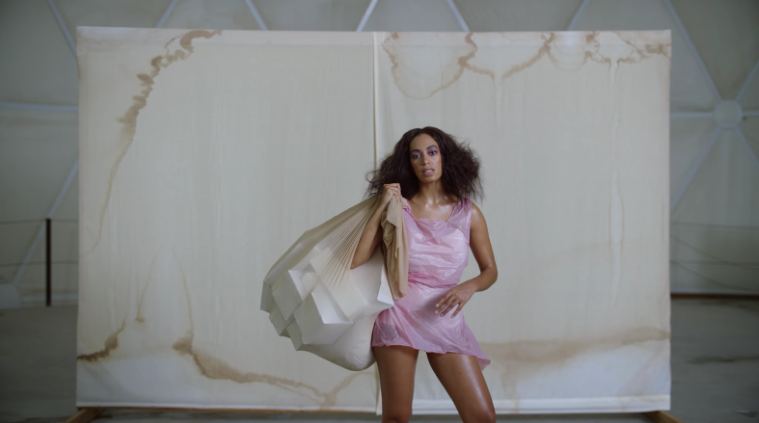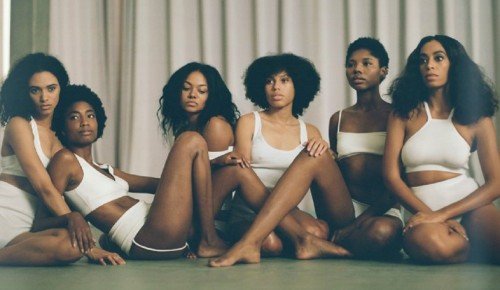For The Culture-
But Never A Seat At The Table
“Blue Monday”, 1983
Annie Lee
The artwork captures the exhausted stillness of a Black woman bearing invisible burdens—reflecting how rest, pain, and resilience often coexist quietly in our bedrooms, far from public recognition.
This project explores the ways African American culture is consumed without context, resisted in its original form, then regurgitated for other cultures to commodify, monetize, and satirize.
It focuses on ownership of one’s image, how members of this cultural group are portrayed in mainstream media, and how these portrayals shape communication both within, outside, and between this group and others. It explores how Black creators use media as a tool of resistance, truth-telling, and cultural preservation.
Oral storytelling in Black American culture has long served as a tool for survival, memory, and resistance.
We weren’t just passing time—we were passing down knowledge, safety strategies, and soul-saving wisdom. Oral storytelling wasn’t optional; it was sacred. It remains one of the most powerful ways we claim space and narrate our own realities.
Gates (1988) highlights the tradition of "signifyin'," a rhetorical practice rooted in wit, wordplay, and layered meaning that passes cultural knowledge across generations.
Judas & The Black Messiah, 2021
Shaka King, Charles King, Ryan Coogler
Griots performing in Sofara, Mali
Williams (2020) describes how hashtags like #LivingWhileBlack expose systemic racism through satire and shared experience, creating both solidarity and critique. Look up #OscarsSoWhite #BlackAFInStem #BlackTikTokStrike and other relevant hashtags to see that these digital expressions are not just jokes—they’re acts of resilience and cultural preservation.
In the absence of mainstream platforms that get it right, we build our own digital language—funny, sharp, and heavy with meaning. And just like our ancestors' tales, these memes carry our truth in ways that outsiders can’t always decode—but we can.
Memes and Black Twitter function as modern-day coded language, continuing the legacy of using humor, irony, and cultural references to speak truth while evading dominant scrutiny.
They are not just used to entertain, but to call out injustice, express collective grief, and archive joy in the face of struggle. The Pew Research Center confirms that Black Americans are more likely to engage politically through digital platforms, often using cultural creativity to do so. This content becomes both a mirror and a microphone.
Cultural imperialism, as described by Hall (1980), occurs when dominant groups control how culture is produced, circulated, and valued—often silencing marginalized voices in the process. On platforms like TikTok, Black creators routinely go uncredited for viral trends, from Peaches Monroe’s “on fleek” to original choreography and memes like the Jordan Crying face. This erasure is modern-day colonization of Black expression, where joy, pain, and creativity—like the “Blue Monday” image—are consumed without context or compensation. These patterns reveal how mainstream media profits from Black culture while denying Black creators authorship and visibility.
"On Fleek" by Peaches Monroee (Kayla Lewis)
A phrase that took the internet by storm, describing perfectly styled eyebrows.
Jalaiah Harmon, the original creator of the viral Renegade dance, was initially erased from the mainstream credit she deserved—a clear example of how Black creativity is often separated from authorship in digital spaces. Her story highlights the ongoing need for visibility, ownership, and respect for the cultural contributions of Black youth in popular media.
What are the risks and rewards of producing unapologetically Black media in a consumer market dominated by non-Black audiences?
The risk is erasure. The reward is legacy.
Producing unapologetically Black media in this climate means walking a tightrope between staying authentic and staying employable.
Representation Without Ownership Isn’t Empowerment.
And Visibility Isn’t The Same As Voice.
Support Black Creators!
With all the recent rollbacks in DEI, this project feels more urgent than ever. Because what's happening in the media reflects bigger issues: who gets to be heard, whose stories get told, and who profits when they do.
By looking at how mainstream media flattens the complexity of Black culture—while lifting the parts it finds profitable—this project shows how cultural imperialism is still alive and well. But it also highlights how Black creators are pushing back—using media as a tool for truth=telling, resistance, and legacy building.
Interconnected
DeAnn Wiley, 2024
DeAnna is an upcoming Black artist with a distinct style that you can’t miss. Your favorite celebrity has probably shared their work that shows Black joy, lived experience, relationships, and community.
Timeline: Shifts in Black Representation in U.S. Media
Producing unapologetically Black media in this climate means walking a tightrope between staying authentic and staying employable.
Black art is in demand, the emotional labor of telling our stories can be draining and underprotected. The Pew Research Center notes that even with increased visibility, Black voices still lack decision-making power.
Solange’s A Seat at the Table
uses personal and familial interludes—featuring her mother Tina Lawson and Master P—to weave oral history into contemporary protest. These spoken moments ground the album in lived Black experience, honoring generational wisdom while confronting systemic erasure. As Gates explains, this blending of voice and narrative reflects a long tradition of signifying and cultural preservation. The album becomes both archive and resistance, using storytelling to assert identity and dignity.
Cranes in the Sky is a quiet confession about the many ways we try to escape our pain, only to realize we’re still carrying it - usually at the most inopportune moments.
Don’t Touch My Hair is a declaration of bodily autonomy and cultural pride, confronting the entitlement often placed on Black expression.




Main Takeaways
-
Oral storytelling has always been a survival tool, a legacy builder, and a cultural map in Black communities.
Before we had the power to read, write, or publish freely, we had our voices. Storytelling is a form of resistance to erasure and a method for preserving memory and identity.
We weren’t just passing time—we were passing down knowledge, safety strategies, and soul-saving wisdom.
Oral storytelling wasn’t optional; it was sacred. It remains one of the most powerful ways we claim space and narrate our own realities.
Digital spaces have become the new front porch, barbershop, or kitchen table—places where community values, warnings, pride, and humor are passed down in coded, creative ways.
-
Williams (2020) shows how memes are used not just to entertain, but to call out injustice, express collective grief, and archive joy in the face of struggle.
The Pew Research Center (2024) confirms that Black Americans are more likely to engage politically through digital platforms, often using cultural creativity to do so. This content becomes both a mirror and a microphone.
In the absence of mainstream platforms that get it right, we build our own digital language—funny, sharp, and heavy with meaning. And just like our ancestors' tales, these memes carry our truth in ways that outsiders can’t always decode—but we can.
-
Cultural imperialism, as described by Hall (1980), occurs when dominant groups control how culture is produced, circulated, and valued—often silencing marginalized voices in the process.
On platforms like TikTok, Black creators routinely go uncredited for viral trends, from Peaches Monroe’s “on fleek” to original choreography and memes like the Jordan Crying face.
This erasure is modern-day colonization of Black expression, where joy, pain, and creativity— the “Blue Monday” image—are consumed without context or compensation. -
The risk is erasure.
Producing unapologetically Black media in this climate means walking a tightrope between staying authentic and staying employable.
Sanders (2021) reminds us that while Black art is in demand, the emotional labor of telling our stories can be draining and underprotected.
Pew (2024) notes that even with increased visibility, Black voices still lack decision-making power.
But the reward? It’s legacy.
When done right, it connects us to each other, it tells the truth, and it becomes medicine. We create new routes to add to the blueprint.
-
Solange used interludes—particularly the voices of her mother Tina Knowles and Master P—to act as griots, threading generational wisdom into the album’s core.
She didn’t just sing; she documented. The personal stories became cultural commentary. These interludes are oral storytelling in the truest sense: reflections on hair, respectability, and economic resilience. They hold space for grief, pride, and clarity.
By centering her family’s lived experiences, Solange gave us a communal soundtrack to healing.
The album doesn’t ask for permission to be Black—it just is, and in doing so, it reminds us that our stories have always been worthy of being heard in our own voices.
Test Your Knowledge!
Test Your Knowledge!
TAKE THIS SHORT QUIZ to see if you picked up what I’m putting down!
Check out all my sources here. Find out why I picked them to support my research. I invite you to go down the rabbit hole of links.
Note from the Author
Growing up near the Heidelberg Project grounded me during some of the most traumatic parts of my childhood—it was proof that beauty, meaning, and resistance could exist in the middle of abandonment. That living art taught me early on that storytelling doesn’t always need words to speak truth.
My goal is not to debate our humanity—it’s to reflect it, honor it, and demand better from the systems and people that exploit it.
As a Black American Woman who’s both witnessed and experienced the misrepresentation of my culture, I created this space to document the truth, celebrate our resilience, and remind us that ownership matters.
This project was created to spotlight a conversation that’s been happening in barbershops, family kitchens, and late-night group chats long before it made it to mainstream media. The culture doesn’t need saving—but the truth needs telling.
This website was created by someone who lives at the intersection of storytelling, culture work, and lived experience.
Subscribe
Subscribe




















